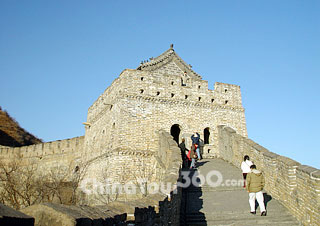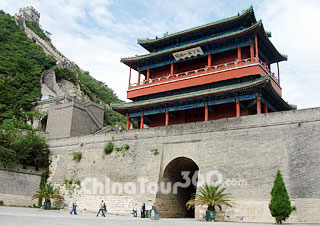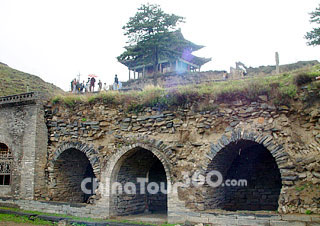 A Signal Tower, Mutianyu
A Signal Tower, Mutianyu An Castle, Xiakou Ancient Town
An Castle, Xiakou Ancient Town Juyongguan Pass, Beijing
Juyongguan Pass, Beijing Great Wall in Datong, Shanxi
Great Wall in Datong, Shanxi
The Great Wall is known for one of the world's seven wonders not only for it is a huge man-made architecture that stretches for tens of hundreds of kilometers in the country but also for the advanced and diversified building technologies in ancient China. Since the earliest wall appeared in the Western Zhou Dynasty (11th Century - 771BC), it has been rebuilt and renovated many times in each feudal dynasty. Because of the differences of functions, construction methods, materials, structures, and locations, the walls of different sections and periods are distinct from each other. For example, the walls constructed before the Northern Wei Dynasty (386 - 557) were mostly built of rammed earth, and bricks came into use from that time. In the Ming Dynasty (1368 - 1644), stones, bricks and mixture of stones and bricks were widely used in the construction of the wall.
Though Great Walls of each period and section are different, they were constructed under one basic principle, which is making full use of the local terrain and materials, and setting up fortresses and passes at crucial and dangerous places. The wall goes up and down with the terrain so to use the natural barriers, such as cliffy peaks, valleys and rivers. In some steep parts, the peak itself became a part of the Wall. For materials, each section of wall was built of local materials. The Western Han Great Wall near Yumenguan Pass was made of sand, gravel, reed and willow branches, because there was no earth or stones in the area. Another example is that the Han-dynasty wall to the west of Xin Us Mountain in Inner Mongolia was piled with rocks, while the section to the east of the mountain was made of rammed earth inside and slates outside, and the material in further east is just earth. The function of thewall is to defend against enemies, so sections of strategic importance were usually built on dangerous terrains, such as the Simatai in Beijing. It is located at the border between Beijing and Hebei Province, which was often attacked by the northern invaders. Therefore the Simatai section was built on the steep mountain ridges and peaks to defend against the invaders.
It is not merely a wall, but a complicated defensive system comprised of walls, guard towers, passes, fortresses, garrison towns, guard houses, and beacon towers, and each were controlled by different military command systems. Take the Ming-dynasty Great Wall as an example. The Ming government set up 9 garrison towns along the wall, which were Liaodong, Ji, Xuanfu, Datong, Shanxi, Yulin, Ningxia, Guyuan, and Gansu. A regional commander was the military chief of each garrison town, who was commanded by the Ministry of War of the central government. In addition, officials and soldiers at all levels were stationed in the guard houses, passes, guard towers, and fortresses.







